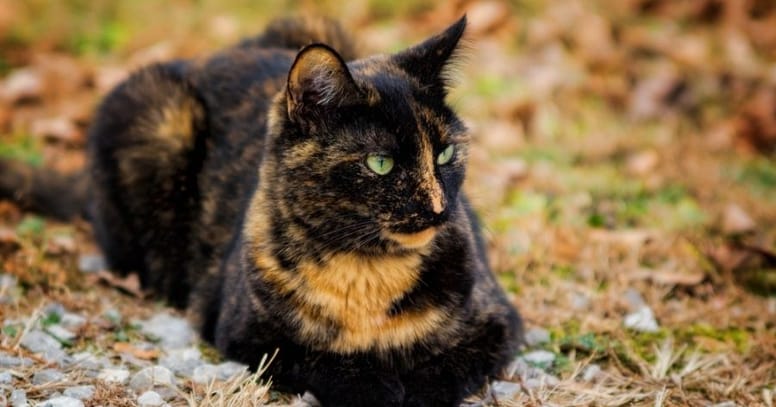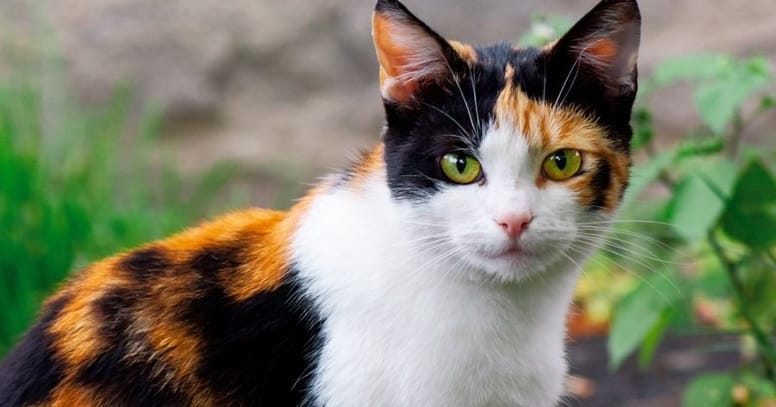When we talk about a calico, tortie, tabby or torbie cat, we are referring to the colour and markings of the cat's coat and not to its possible breed. Some pedigree cats may be referred to as calico, tortie or torbie, just like domestic cats.
The terms tortie, tabby and calico refer to coat colour, whereas the term torbie mixes coat colour and markings, as it is a tabby with a tortoiseshell coat like the tortie. It is also possible to be both calico and tabby.
They are all multicoloured cats, and can be confused quite easily if you don't know what you are looking for. The particular colouring of the cats can also have an impact on their sex: you will rarely find a male tortie or calico, for example, even if it exists!
Do you have a beautiful cat with multi-coloured markings and are wondering if it could be a calico, tortie, tabby or torbie? Here's how to tell the difference between all these beautiful colours!
The tortoiseshell cat (tortie cat)

A cat with a beautiful ginger and black coat with a marbled effect is usually a tortie, or tortoiseshell cat, because of their resemblance to the shell of a tortoise. Tortie cats are usually ginger and black, but can also have hints of cream, gold, blue, lilac or beige colours. This is known as the diluted tortoiseshell colour. Tortie cats, on the other hand, never have white in their coats!
Tortie cats are almost always female, because the gene responsible for this colouring is located in the X chromosome, and cats need two X genes to have this appearance. While male Torties do exist, they are incredibly rare. Only about 1 in 3000 male cats have the Tortoiseshell pattern! They have an extra X chromosome (XXY) and are usually sterile.
There are a few pure cat breeds who may exhibit the Tortoiseshell pattern such as Maine Coons and Persians.
The calico cat

Calico cats have a multi-coloured coat which is often confused with the tortie cat. However, it is easy to tell the difference! Calico cats have between 25 to 75% white in their coat, with large areas of red, black, blue or grey. Their tricolour coat is called "piebald", which means that there are non pigmented areas, hence the white colour. There are also diluted calico cats, which have grey, silver or even golden shades in their coat colours, without dark colours such as brown or black.
The cat’s colour is, as we have mentioned above, determined by their X chromosome. Therefore, just like their Tortie friends, Calico cats are also most often female due to their genes. Calico cats inherit one Big O (or dominant gene) and one Little o (or recessive gene). This “Oo” combination is at the origin of the tri-color look that is unique to the Calico cat.
Famous calico cats include the Maneki Neko, the Japanese lucky cat, which is a Japanese Bobtail calico!
The tabby cat

What distinguishes the coat of a tabby cat is the markings on its coat with a marbled or striped effect, with dark spots on a light background. It is these markings that distinguish the tabby, not the colour of the coat beneath the markings.
The most distinctive marking of a tabby cat is the M-shape on its foreheads. In general, they have striped markings on their eyes, cheeks, paws and tail, which give a nice visual effect that helps a lot with camouflage. Depending on the type of tabby, they can have all sorts of marbled, striped, spotted or even swirled coloured effects on the body, neck, shoulders, belly, etc. Tabby cats can come in all sorts of colours:
- Black tabby
- Brown tabby
- Red tabby
- Grey tabby
- Orange tabby
- Cream tabby
- Silver tabby
And much more!
It is a marking that exists in many pedigree cats, including the Maine Coon for which it is the most common type of marking, as well as in the domestic cat.
The torbie cat

The torbie cat is very rare and the most difficult to differentiate. The term "torbie" refers to both the colour of a cat's coat and its markings. Torbie cats are tortie or calico cats that have the markings of the tabby cat. The term torbie is a mix between the words tortoiseshell and tabby.
Thus, torbie cats have a marbled or striped effect, with dark spots on a light background and white areas if the base colour is calico. These markings can be found anywhere on the animal's body; for example, on the paws, cheeks, eyes, tail, belly, shoulders, and have a striped, tabby, marbled, spotted effect. They have red or cream spots in their coats too.
Torbies are therefore tortie AND tabby or calico AND tabby.
Yes, it’s all a little confusing and sometimes not easy to figure out: with calico, tortie tabby and torbie cats, every combination can happen! Whatever your cat's coat type, he is perfect as he is. His coat type may be affected by his genes, but the most important thing is that his coat is healthy!

